To Adopt CCU Technology or Not? An Evolutionary Game between Local Governments and Coal-Fired Power Plants
Abstract
:1. Introduction
2. Literature Review
3. Evolutionary Game Model
3.1. Model Assumption
3.2. Payoffs of Players
3.3. Strategy Stability Analysis
3.3.1. Strategy Stability Analysis of Local Governments
3.3.2. Strategy Stability Analysis of Coal-Fired Power Plants
3.3.3. ESS Analysis between Local Governments and Coal-Fired Power Plants
4. System Simulation Analysis
4.1. Simulation Results
4.2. Sensitivity Analysis
4.2.1. Unit Price of Hydrogen (j)
4.2.2. Unit Price of Carbon Dioxide-Derived Chemicals (k)
4.2.3. Regulatory Cost ()
4.2.4. Punishments on Power Plants (P)
4.2.5. Subsidies on Power Plants (W)
5. Conclusions and Policy Implications
5.1. Conclusions
5.2. Implications for Stakeholders
5.3. Limitations
Author Contributions
Funding
Institutional Review Board Statement
Informed Consent Statement
Data Availability Statement
Conflicts of Interest
Abbreviations
| R | Local government’s initial revenue |
| Additional environmental benefits for local governments from CCU technology deployment | |
| Annual regulatory cost of local governments | |
| Annual environmental cost of local governments | |
| W | Subsidies power plants receive for CCU technology deployment |
| CCU equipment cost | |
| Carbon capture cost | |
| Annual cost for purchasing hydrogen | |
| Extra cost for CCU technology deployment | |
| D | Proceeds from the sale of CCU derivatives |
| L | Extra profit for CCU technology deployment |
| S | Initial income of power plant |
| P | Penalties for power plants from local governments |
| n | Amount of captured carbon dioxide |
| Efficiency of carbon dioxide conversion to derivatives | |
| j | Unit price of hydrogen |
| k | Unit price of carbon dioxide-derived chemicals |
| x | Probability that local governments choose the “regulate” strategy |
| y | Probability that power plants choose the “adopt” strategy |
References
- He, J.; Li, J.; Zhao, D.; Chen, X. Does oil price affect corporate innovation? Evidence from new energy vehicle enterprises in China. Renew. Sustain. Energy Rev. 2022, 156, 111964. [Google Scholar] [CrossRef]
- Mikulčić, H.; Skov, I.R.; Dominković, D.F.; Alwi, S.R.W.; Manan, Z.A.; Tan, R.; Duić, N.; Mohamad, S.N.H.; Wang, X. Flexible Carbon Capture and Utilization technologies in future energy systems and the utilization pathways of captured CO2. Renew. Sustain. Energy Rev. 2019, 114, 109338. [Google Scholar] [CrossRef]
- IEA. Net Zero by 2050. 2021. Available online: https://www.iea.org/reports/net-zero-by-2050/ (accessed on 9 March 2022).
- Mennicken, L.; Janz, A.; Roth, S. The German R&D program for CO2 utilization—Innovations for a green economy. Environ. Sci. Pollut. Res. 2016, 23, 11386–11392. [Google Scholar]
- Meylan, F.D.; Moreau, V.; Erkman, S. CO2 utilization in the perspective of industrial ecology, an overview. J. CO2 Util. 2015, 12, 101–108. [Google Scholar] [CrossRef]
- Thonemann, N.; Zacharopoulos, L.; Fromme, F.; Nühlen, J. Environmental impacts of carbon capture and utilization by mineral carbonation: A systematic literature review and meta life cycle assessment. J. Clean. Prod. 2022, 332, 130067. [Google Scholar] [CrossRef]
- Mallapragada, D.S.; Gençer, E.; Insinger, P.; Keith, D.W.; O’Sullivan, F.M. Can industrial-scale solar hydrogen supplied from commodity technologies Be cost competitive by 2030? Cell Rep. Phys. Sci. 2020, 1, 100174. [Google Scholar] [CrossRef]
- Psarras, P.C.; Comello, S.; Bains, P.; Charoensawadpong, P.; Reichelstein, S.; Wilcox, J. Carbon capture and utilization in the industrial sector. Environ. Sci. Technol. 2017, 51, 11440–11449. [Google Scholar] [CrossRef]
- Ho, H.J.; Iizuka, A.; Shibata, E. Carbon capture and utilization technology without carbon dioxide purification and pressurization: A review on its necessity and available technologies. Ind. Eng. Chem. Res. 2019, 58, 8941–8954. [Google Scholar] [CrossRef]
- Ravikumar, D.; Keoleian, G.; Miller, S. The environmental opportunity cost of using renewable energy for carbon capture and utilization for methanol production. Appl. Energy 2020, 279, 115770. [Google Scholar] [CrossRef]
- Li, K.; Shen, S.; Fan, J.L.; Xu, M.; Zhang, X. The role of carbon capture, utilization and storage in realizing China’s carbon neutrality: A source-sink matching analysis for existing coal-fired power plants. Resour. Conserv. Recycl. 2022, 178, 106070. [Google Scholar] [CrossRef]
- Jia, Z.; Lin, B. How to achieve the first step of the carbon-neutrality 2060 target in China: The coal substitution perspective. Energy 2021, 233, 121179. [Google Scholar] [CrossRef]
- Cai, B.; Li, Q.; Zhang, X. China CCUS Annual Report (2021)-China CCUS Path Research. 2021. Available online: http://www.cityghg.com/a/news/2021/0726/194.html (accessed on 9 March 2022).
- Jiang, K.; Ashworth, P.; Zhang, S.; Liang, X.; Sun, Y.; Angus, D. China’s carbon capture, utilization and storage (CCUS) policy: A critical review. Renew. Sustain. Energy Rev. 2020, 119, 109601. [Google Scholar] [CrossRef]
- Bowen, F. Carbon capture and storage as a corporate technology strategy challenge. Energy Policy 2011, 39, 2256–2264. [Google Scholar] [CrossRef]
- Arning, K.; Offermann-van Heek, J.; Sternberg, A.; Bardow, A.; Ziefle, M. Risk-benefit perceptions and public acceptance of Carbon Capture and Utilization. Environ. Innov. Soc. Transit. 2020, 35, 292–308. [Google Scholar] [CrossRef]
- Bruhn, T.; Naims, H.; Olfe-Kräutlein, B. Separating the debate on CO2 utilisation from carbon capture and storage. Environ. Sci. Policy 2016, 60, 38–43. [Google Scholar] [CrossRef]
- Aldaco, R.; Butnar, I.; Margallo, M.; Laso, J.; Rumayor, M.; Dominguez-Ramos, A.; Irabien, A.; Dodds, P.E. Bringing value to the chemical industry from capture, storage and use of CO2: A dynamic LCA of formic acid production. Sci. Total Environ. 2019, 663, 738–753. [Google Scholar] [CrossRef]
- Cormos, A.M.; Dinca, C.; Petrescu, L.; Chisalita, D.A.; Szima, S.; Cormos, C.C. Carbon capture and utilisation technologies applied to energy conversion systems and other energy-intensive industrial applications. Fuel 2018, 211, 883–890. [Google Scholar] [CrossRef]
- Chen, Q.; Gu, Y.; Tang, Z.; Wei, W.; Sun, Y. Assessment of low-carbon iron and steel production with CO2 recycling and utilization technologies: A case study in China. Appl. Energy 2018, 220, 192–207. [Google Scholar] [CrossRef]
- Farfan, J.; Fasihi, M.; Breyer, C. Trends in the global cement industry and opportunities for long-term sustainable CCU potential for Power-to-X. J. Clean. Prod. 2019, 217, 821–835. [Google Scholar] [CrossRef]
- Lu, L.; Guest, J.S.; Peters, C.A.; Zhu, X.; Rau, G.H.; Ren, Z.J. Wastewater treatment for carbon capture and utilization. Nat. Sustain. 2018, 1, 750–758. [Google Scholar] [CrossRef]
- Wang, G.; Chao, Y.; Chen, Z. Promoting developments of hydrogen powered vehicle and solar PV hydrogen production in China: A study based on evolutionary game theory method. Energy 2021, 237, 121649. [Google Scholar] [CrossRef]
- Gao, X.; Shen, J.; He, W.; Sun, F.; Zhang, Z.; Guo, W.; Zhang, X.; Kong, Y. An evolutionary game analysis of governments’ decision-making behaviors and factors influencing watershed ecological compensation in China. J. Environ. Manag. 2019, 251, 109592. [Google Scholar] [CrossRef] [PubMed]
- Shan, H.; Yang, J. Sustainability of photovoltaic poverty alleviation in China: An evolutionary game between stakeholders. Energy 2019, 181, 264–280. [Google Scholar] [CrossRef]
- Kabir, K.A.; Tanimoto, J. Evolutionary game theory modelling to represent the behavioural dynamics of economic shutdowns and shield immunity in the COVID-19 pandemic. R. Soc. Open Sci. 2020, 7, 201095. [Google Scholar] [CrossRef] [PubMed]
- Wang, G.; Chao, Y.; Jiang, T.; Chen, Z. Facilitating developments of solar thermal power and nuclear power generations for carbon neutral: A study based on evolutionary game theoretic method. Sci. Total Environ. 2021, 814, 151927. [Google Scholar] [CrossRef]
- Qiao, W.; Yin, X. Understanding the impact on energy transition of consumer behavior and enterprise decisions through evolutionary game analysis. Sustain. Prod. Consum. 2021, 28, 231–240. [Google Scholar] [CrossRef]
- Zhao, T.; Liu, Z. A novel analysis of carbon capture and storage (CCS) technology adoption: An evolutionary game model between stakeholders. Energy 2019, 189, 116352. [Google Scholar] [CrossRef]
- Ji, S.; Zhao, D.; Luo, R. Evolutionary game analysis on local governments and manufacturers’ behavioral strategies: Impact of phasing out subsidies for new energy vehicles. Energy 2019, 189, 116064. [Google Scholar] [CrossRef]
- Friedman, D. Evolutionary games in economics. Econom. J. Econom. Soc. 1991, 59, 637–666. [Google Scholar] [CrossRef] [Green Version]
- Daily, F.F. CPI Carbon Capture Device Officially Put into Operation. 2010. Available online: https://www.in-en.com/article/html/energy-559116.shtml (accessed on 9 March 2022).
- Nyári, J.; Magdeldin, M.; Larmi, M.; Järvinen, M.; Santasalo-Aarnio, A. Techno-economic barriers of an industrial-scale methanol CCU-plant. J. CO2 Util. 2020, 39, 101166. [Google Scholar] [CrossRef]
- Hoppe, W.; Thonemann, N.; Bringezu, S. Life cycle assessment of carbon dioxide–based production of methane and methanol and derived polymers. J. Ind. Ecol. 2018, 22, 327–340. [Google Scholar] [CrossRef]
- Kauw, M. Recycling of CO2, the Perfect Biofuel; University of Groningen: Groningen, The Netherlands, 2012. [Google Scholar]
- Chen, W.; Hu, Z.H. Analysis of multi-stakeholders’ behavioral strategies considering public participation under carbon taxes and subsidies: An evolutionary game approach. Sustainability 2020, 12, 1023. [Google Scholar] [CrossRef] [Green Version]
- Council, H. Path to Hydrogen Competitiveness: A Cost Perspective; Institution of Gas Engineers & Managers: Kegworth, UK, 2020. [Google Scholar]
- Fan, J.L.; Yu, P.; Li, K.; Xu, M.; Zhang, X. A levelized cost of hydrogen (LCOH) comparison of coal-to-hydrogen with CCS and water electrolysis powered by renewable energy in China. Energy 2022, 242, 123003. [Google Scholar] [CrossRef]
- Yu, M.; Wang, K.; Vredenburg, H. Insights into low-carbon hydrogen production methods: Green, blue and aqua hydrogen. Int. J. Hydrog. Energy 2021, 46, 21261–21273. [Google Scholar] [CrossRef]
- Hank, C.; Gelpke, S.; Schnabl, A.; White, R.J.; Full, J.; Wiebe, N.; Smolinka, T.; Schaadt, A.; Henning, H.M.; Hebling, C. Economics & carbon dioxide avoidance cost of methanol production based on renewable hydrogen and recycled carbon dioxide–power-to-methanol. Sustain. Energy Fuels 2018, 2, 1244–1261. [Google Scholar]
- Gao, L.; Zhao, Z.Y. The evolutionary game of stakeholders’ coordination mechanism of new energy power construction PPP project: A China case. Sustainability 2020, 12, 1045. [Google Scholar] [CrossRef] [Green Version]

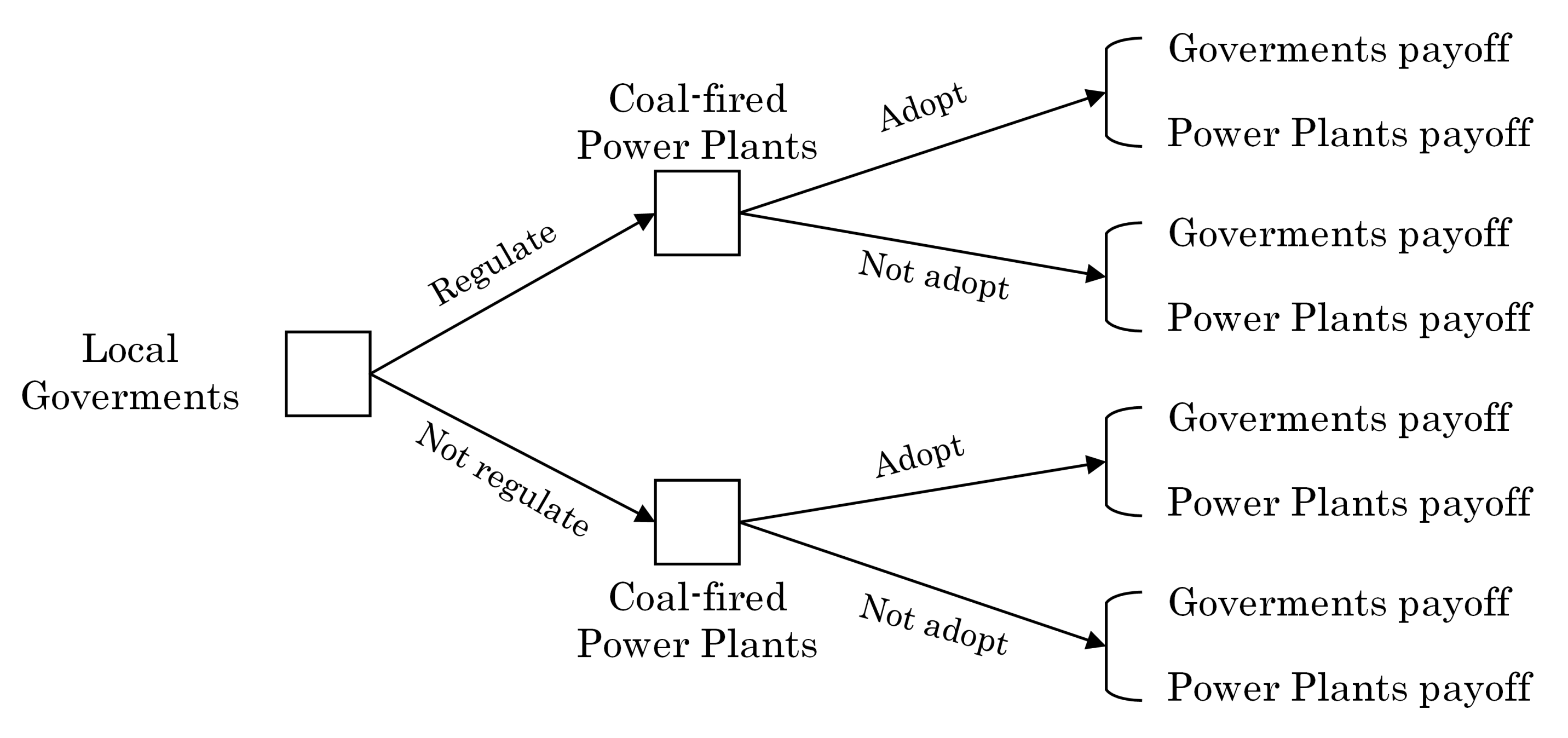



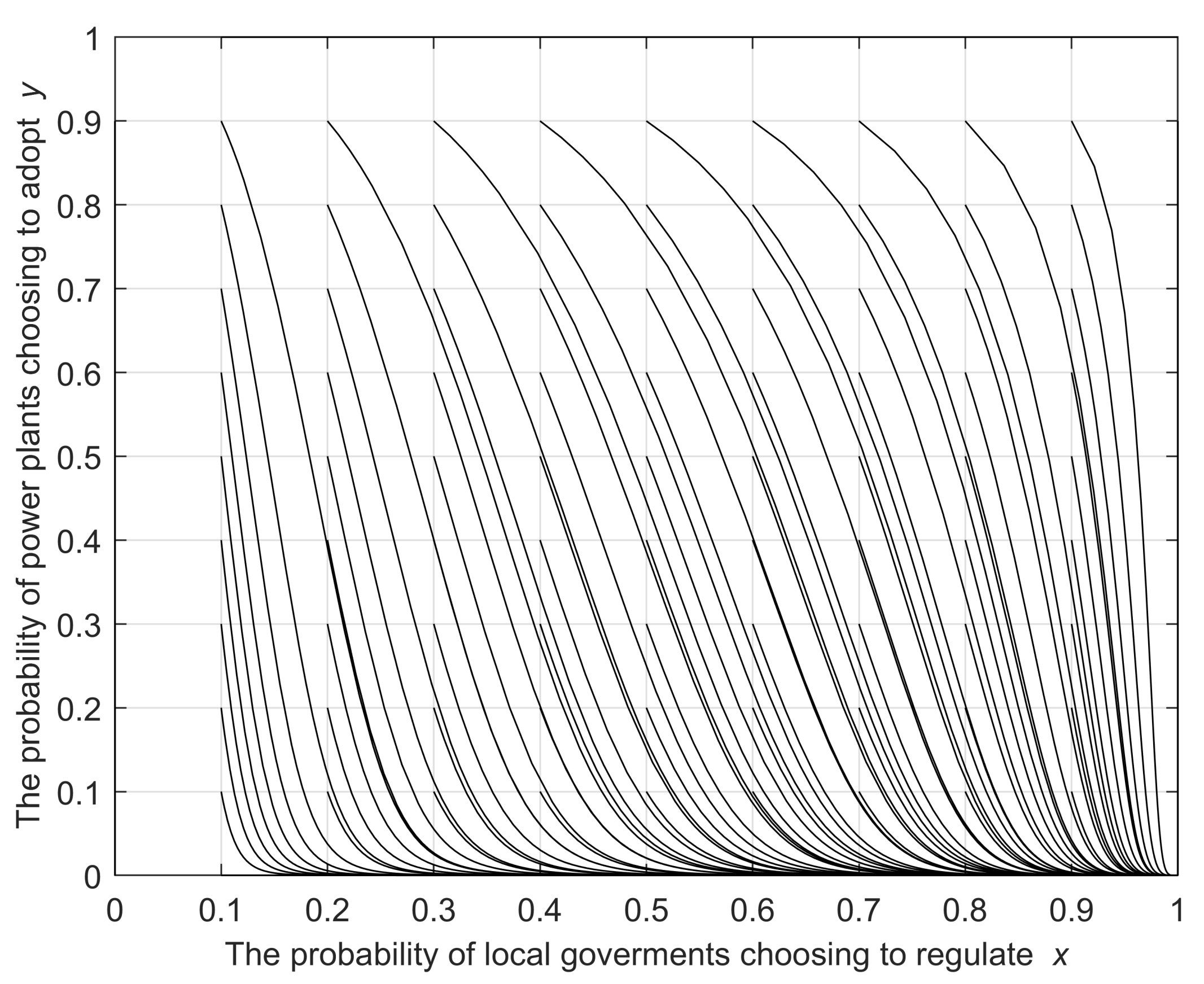
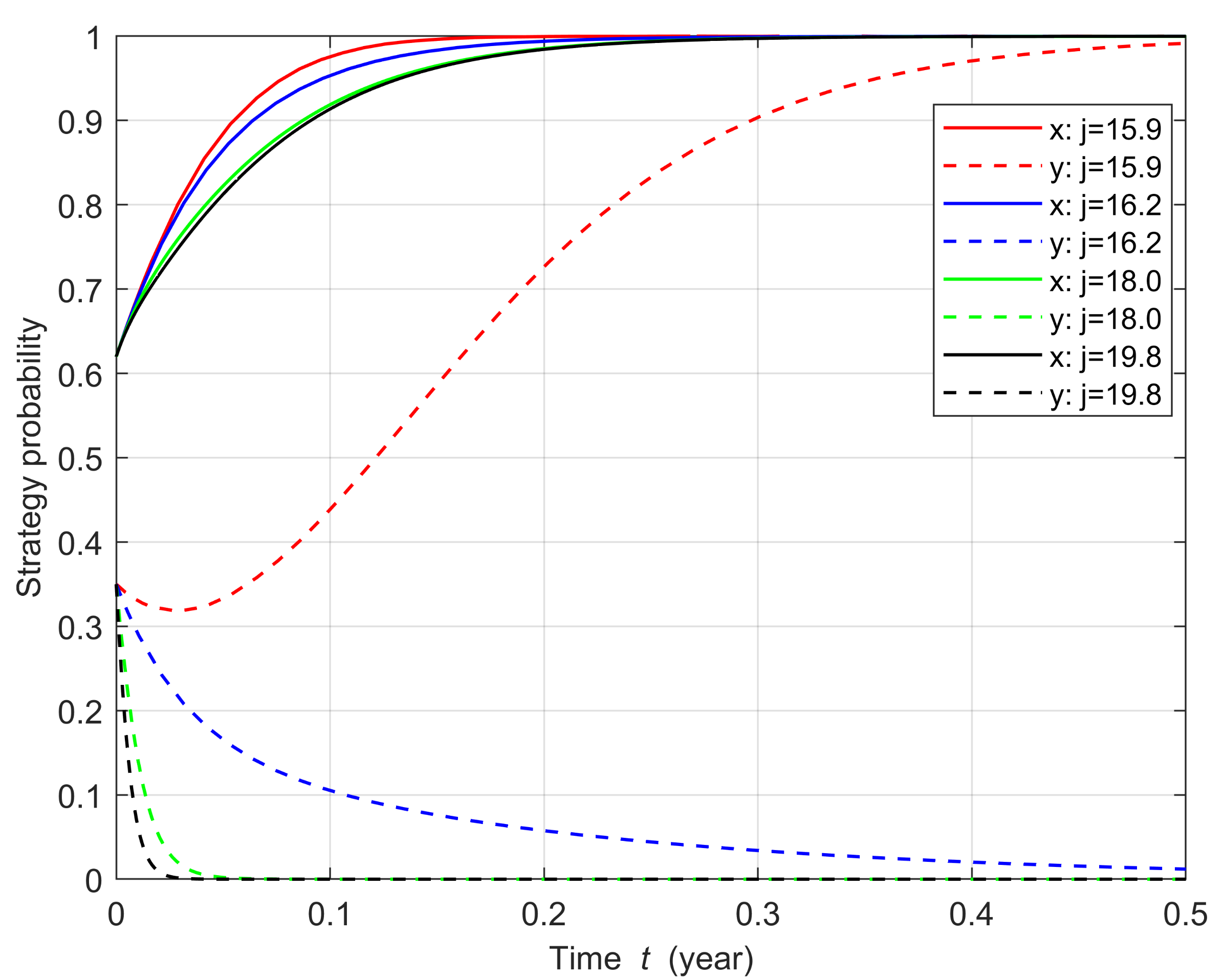
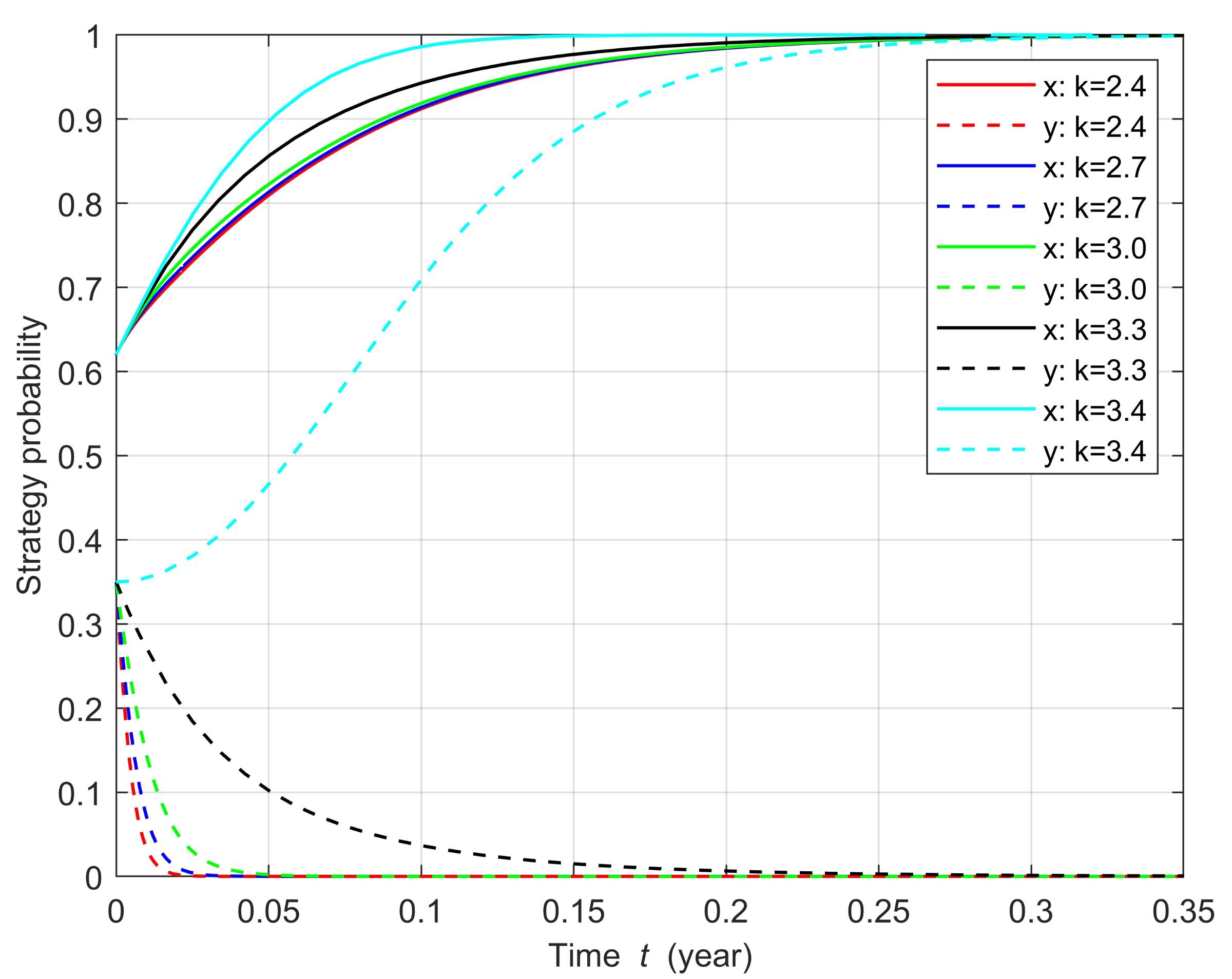


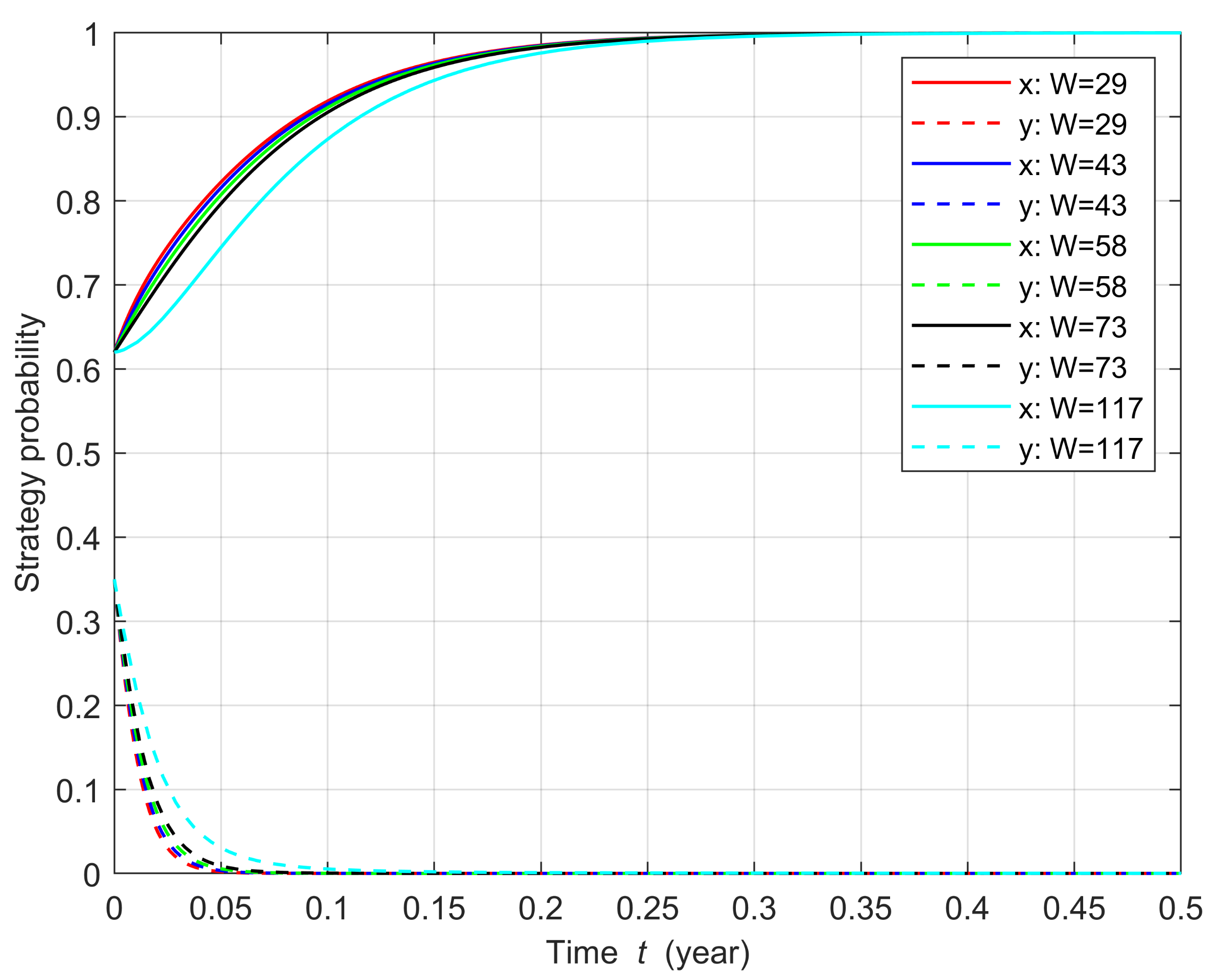
| Coal-Fired Power Plants | |||
|---|---|---|---|
| Adopt (y) | Not Adopt () | ||
| Local governments | Regulate (x) | (, ) | (, ) |
| Not regulate () | (R,) | (, S) | |
| Points | detJ | trJ |
|---|---|---|
| 0 |
| Points | detJ | trJ | State | detJ | trJ | State | detJ | trJ | State |
|---|---|---|---|---|---|---|---|---|---|
| Case 1 | Case 2 | Case 3 | |||||||
| + | + | Unstable | − | N | Saddle point | − | N | Saddle point | |
| + | + | Unstable | + | + | Unstable | + | + | Unstable | |
| − | + | Saddle point | − | N | Saddle point | + | − | ESS | |
| + | − | ESS | + | − | ESS | − | N | Saddle point | |
| + | 0 | Central point | + | 0 | Central point | − | 0 | Saddle point | |
| Case 4 | Case 5 | Case 6 | |||||||
| − | N | Saddle point | + | − | ESS | + | − | ESS | |
| − | N | Saddle point | + | + | Unstable | + | + | Unstable | |
| + | + | Unstable | + | + | Unstable | − | N | Saddle point | |
| + | − | ESS | + | − | ESS | − | N | Saddle point | |
| + | 0 | Central point | − | 0 | Saddle point | + | 0 | Central point | |
| Case 7 | Case 8 | Case 9 | |||||||
| − | N | Saddle point | + | − | ESS | + | − | ESS | |
| + | − | ESS | − | N | Saddle point | − | N | Saddle point | |
| − | + | Saddle point | + | + | Unstable | − | N | Saddle point | |
| − | N | Saddle point | − | N | Saddle point | + | + | Unstable | |
| + | 0 | Central point | − | 0 | Saddle point | + | 0 | Central point | |
Publisher’s Note: MDPI stays neutral with regard to jurisdictional claims in published maps and institutional affiliations. |
© 2022 by the authors. Licensee MDPI, Basel, Switzerland. This article is an open access article distributed under the terms and conditions of the Creative Commons Attribution (CC BY) license (https://creativecommons.org/licenses/by/4.0/).
Share and Cite
Nie, S.; Cai, G.; Li, Y.; Chen, Y.; Bai, R.; Gao, L.; Chen, X. To Adopt CCU Technology or Not? An Evolutionary Game between Local Governments and Coal-Fired Power Plants. Sustainability 2022, 14, 4768. https://doi.org/10.3390/su14084768
Nie S, Cai G, Li Y, Chen Y, Bai R, Gao L, Chen X. To Adopt CCU Technology or Not? An Evolutionary Game between Local Governments and Coal-Fired Power Plants. Sustainability. 2022; 14(8):4768. https://doi.org/10.3390/su14084768
Chicago/Turabian StyleNie, Shuai, Guotian Cai, Yixuan Li, Yushu Chen, Ruxue Bai, Liping Gao, and Xiaoyu Chen. 2022. "To Adopt CCU Technology or Not? An Evolutionary Game between Local Governments and Coal-Fired Power Plants" Sustainability 14, no. 8: 4768. https://doi.org/10.3390/su14084768






